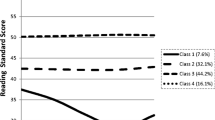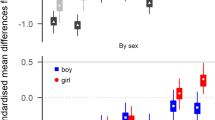Abstract
In view of the paucity of detailed followup studies on hyperactive children, the performance of 15 adolescents diagnosed hyperactive 5 years previously was compared to that of a control group of equivalent age, sex, intelligence, and social class. Eleven cognitive tests measuring sustained attention, visual-motor and motor skills, abstraction, and reading ability, as well as three self-assessment tests examining selfesteem, activity level, social functioning, academic status, and career aspirations were administered. The hyperactives performed significantly worse than the controls on the sustained attention, visualmotor, and motor tasks, and on two of the four reading tests. They also gave themselves significantly lower ratings on some of the selfesteem and sociability items. It would appear that the hyperactives at adolescence still have attentional and stimulus-processing difficulties, which affect not only their academic performance but also their social functioning.
Similar content being viewed by others
References
Argyle, M.The psychology of interpersonal behavior. London: Penguin, 1972.
Battle, E., & Lacey, B. A context for hyperactivity in children over time.Child Development, 1972,43, 757–773.
Campbell, S., Douglas, V., & Morgenstern, G. Cognitive styles of hyperactive children and the effect of methylphenidate.Journal of Child Psychology and Psychiatry, 1971,12, 55–67.
Cantwell, D.The hyperactive child: Diagnosis, management, and current research. New York: Spectrum, 1975.
Cohen, N., Weiss, G., & Minde, K. Cognitive styles in adolescents previously diagnosed as hyperactive.Journal of Child Psychology and Psychiatry, 1972,13, 203–209.
Davidson, H., & Lang, G. Children's perceptions of their teachers' feelings toward them related to self-perception, school achievement, and behavior.Journal of Experimental Education, 1960,29, 107–118.
Douglas, V. Stop, look and listen: The problem of sustained attention and impulse control in hyperactive and normal children.Canadian Journal of Behavioral Science, 1972,4, 259–281.
Durost, W., Bixler, H., Hildreth, G., Lund, K., & Wrightstone, J.Metropolitan achievement tests. New York: Harcourt, Brace, & World, 1960.
Harris, D.Children's drawing as measures of intellectual maturity: A revision and extension of the Goodenough Draw-A-Man Test. New York: Harcourt, Brace, & World, 1963.
Hechtman, L., Weiss, G., Finklestein, J., Werner, A., & Benn, R. Hyperactives as young adults: Preliminary report.Canadian Medical Journal, 1976,115, 625–630.
Hollingshead, A., & Redlich, F.Social class and mental illness: A community study. New York: Wiley, 1958.
Jeffrey, W. The orienting reflex and attention in cognitive development.Psychological Review, 1968,75, 323–334.
Kelley, T., Madden, R., Gardner, E., Terman, L., & Ruch, G.Stanford achievement test. New York: World Book Company, 1953.
Koppitz, E.The Bender-Gestalt test for young children. New York: Grune & Stratton, 1964.
Laufer, M., & Denhoff, E. Hyperkinetic behavior syndrome in children.Journal of Pediatrics, 1957,50, 463–474.
Lytton, G., & Knobel, M. Diagnosis and treatment of behavior disorders in children.Diseases of the Nervous System, 1958,20, 5–11.
Mendelson, W., Johnson, N., & Stewart, M. Hyperactive children as teenagers: A follow-up study.Journal of Nervous and Mental Disease, 1971,153, 273–279.
Minde, K., Lewin, D., Weiss, G., Lavigueur, H., Douglas, V., & Sykes, E. The hyperactive child in elementary school: A 5-year, controlled follow-up.Exceptional Children, 1971,38, 215–221.
Minde, K., Weiss, G., & Mendelson, N. A 5-year follow-up study of 91 hyperactive school children.Journal of the American Academy of Child Psychiatry, 1972,11, 595–610.
Robinson, H., & Gray, W.Gray oral reading test. New York: Bobbs-Merrill, 1963.
Sloan, W.The Lincoln adaptation of the Oseretsky tests: A measure of motor proficiency. Lincoln, Illinois: Lincoln State School, 1948.
Stewart, M., Mendelson, W., & Johnson, N. Hyperactive children as adolescents: How they describe themselves.Child Psychiatry and Human Development, 1973,4, 3–11.
Sykes, D., Douglas, V., Weiss, G., & Minde, K. Attention in hyperactive children and the effect of methylphenidate (Ritalin).Journal of Child Psychology and Psychiatry, 1971,12, 129–139.
Sykes, D., Douglas, V., & Morgenstern, G. Sustained attention in hyperactive children.Journal of Child Psychology and Psychiatry, 1973,14, 213–220.
Weiss, G., Minde, K., Werry, J., Douglas, V., & Nemeth, E. Studies on the hyperactive child: VIII. Five-year follow-up.Archives of General Psychiatry, 1971,24, 409–414.
Werry, J. Developmental hyperactivity.Pediatric Clinics of North America, 1968,15, 581–599.
Wylie, R.The self-concept: A critical survey of pertinent research literature. Lincoln: University of Nebraska Press, 1961.
Ziller, R., Hagey, J., Smith, M., & Long, B. Self-esteem: A self-social construct.Journal of Consulting and Clinical Psychology, 1969,33, 84–95.
Author information
Authors and Affiliations
Additional information
This study was supported by a Federal-Provincial Mental Health Grant to Dr. G. Weiss. The authors wish to thank Katherine Levine and Margaret Radigan for their assistance with test preparation and scoring. Thanks are also extended to Ken MacRae for his computer-processing advice, particularly his help with several multivariate and principal components analyses from which the present authors have derived their current theoretical position. Klaus Minde and Nancy Cohen are now at the Toronto Hospital for Sick Children, while Elizabeth Hoy is at the Queen's University of Belfast, Northern Ireland.
Rights and permissions
About this article
Cite this article
Hoy, E., Weiss, G., Minde, K. et al. The hyperactive child at adolescence: Cognitive, emotional, and social functioning. J Abnorm Child Psychol 6, 311–324 (1978). https://doi.org/10.1007/BF00924734
Revised:
Issue Date:
DOI: https://doi.org/10.1007/BF00924734




